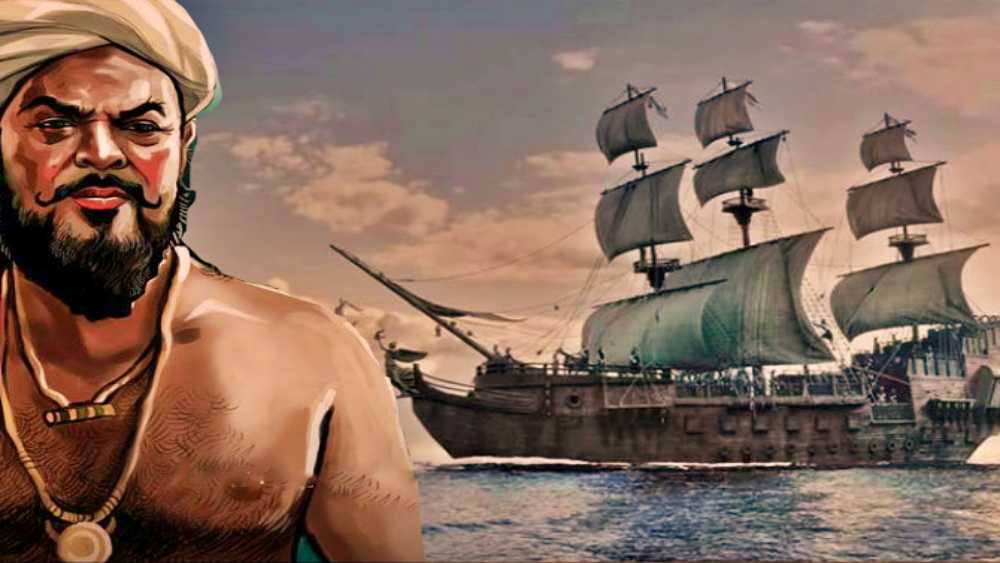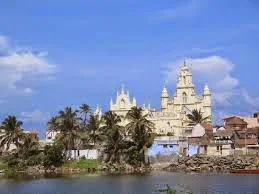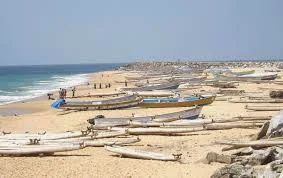
Author: Belleforest, F. de.
PlaceAndYear: Paris, 1575.
Description: Francois de Belleforest (1530-1583). Edited a French edition of Sebastian M�nster's 'Cosmography', named 'La Cosmographie universelle', 1575. An early woodcut bird-eye's view of the town of Calicut as seen from the sea, with ships in the foreground and right a ship's yard.
See also
Indian Pirates: From the Earliest Times to the Present Day
======================================
Pirates in the History of Calicut - Calicut Heritage
Malabar Hill and the Pirates of Malabar
Malabar Hill and the Pirates of Malabar
The Pirates of Malabar,
and An Englishwoman in India Two Hundred Years Ago
by John Biddulph
===========
== *Introduction by FWP*
== *Views of the Malabar Coast*
== *Author's preface*
*Chapter I: The Rise of European Piracy in the East*
Portuguese pirates-- Vincente Sodre-- Dutch pirates-- Royal filibustering-- Endymion Porter's venture-- The Courten Association-- The Indian Red Sea fleet-- John Hand-- Odium excited against the English in Surat-- The Caesar attacked by French pirates-- Danish depredations-- West Indian pirates-- Ovington's narrative-- Interlopers and permission ships-- Embargo placed on English trade-- Rovers trapped at Mungrole-- John Steel-- Every seizes the Charles the Second and turns pirate-- His letter to English commanders-- The Madagascar settlements-- Libertatia-- Fate of Sawbridge-- Capture of the Gunj Suwaie-- Immense booty-- Danger of the English at Surat-- Bombay threatened-- Friendly behaviour of the Surat Governor-- Embargo on European trade-- Every sails for America-- His reputed end-- Great increase of piracy-- Mutiny of the Mocha and Josiah crews-- Culliford in the Resolution-- The London seized by Imaum of Muscat
*Chapter II: Captain Kidd*
Measures to suppress piracy-- The Adventure fitted out-- Warren's squadron meets with Kidd-- His suspicious behaviour-- He threatens the Sidney-- Waylays the Red Sea fleet-- Captures the Mary-- Visits Carwar and Calicut-- His letter to the factory-- Chased by Portuguese men-of-war-- Chases the Sedgwick-- Chivers-- Action between Dorrill and Resolution-- Kidd captures the Quedah Merchant-- Dilemma of European traders at Surat-- Their agreements with the authorities-- Experience of the Benjamin-- News of Kidd's piracies reaches England-- Despatch of squadron under Warren-- Littleton at Madagascar-- Kidd sails for New York-- Arrested and tried-- His defence and execution-- Justice of his sentence-- His character-- Diminution of piracy-- Lowth in the Loyal Merchant-- Act for suppression of piracy-- Captain Millar
*Chapter III: The Rise of Conajee Angria*
Native piracy hereditary on the Malabar coast-- Marco Polo's account-- Fryer's narrative-- The Kempsant-- Arab and Sanganian pirates-- Attack on the President-- Loss of the Josiah-- Attack on the Phoenix-- The Thomas captured-- Depredations of the Gulf pirates-- Directors' views-- Conajee Angria-- Attacks English ships-- Destroys the Bombay-- Fortifies Kennery-- Becomes independent-- Captures the Governor's yacht-- Attacks the Somers and Grantham-- Makes peace with Bombay-- His navy-- Great increase of European and native piracy
*Chapter IV: An Active Governor*
Arrival of Mr. Boone as Governor-- He builds ships and improves defences of Bombay-- Desperate engagement of Morning Star with Sanganians-- Alexander Hamilton-- Expedition against Vingorla-- Its failure-- Hamilton made Commodore-- Expedition against Carwar-- Landing force defeated-- Successful skirmish-- Desertion of Goa recruits-- Reinforcements-- Landing force again defeated-- The Rajah makes peace-- Hamilton resigns Commodoreship-- A noseless company-- Angria recommences attacks-- Abortive expedition against Gheriah-- Downing's account of it-- Preparations to attack Kennery
*Chapter V: The Company's Servants*
The Company's civil servants-- Their comparison with English who went to America-- Their miserable salaries-- The Company's military servants-- Regarded with distrust-- Shaxton's mutiny-- Captain Keigwin-- Broken pledges and ill-treatment-- Directors' vacillating policy-- Military grievances-- Keigwin seizes the administration of Bombay-- His wise rule-- Makes his submission to the Crown-- Low status of Company's military officers-- Lord Egmont's speech-- Factors and writers as generals and colonels-- Bad quality of the common soldiers-- Their bad treatment-- Complaint against Midford-- Directors' parsimony
*Chapter VI: Expedition Against Kennery*
Sivajee's occupation of Kennery-- A naval action-- Minchin and Keigwin-- Bombay threatened-- The Seedee intervenes-- Conajee Angria occupies Kennery-- Boone sails with the expedition-- Manuel de Castro-- Futile proceedings-- Force landed and repulsed-- Second landing-- Manuel de Castro's treachery-- Gideon Russell-- Bad behaviour of two captains-- Defeat-- Attack abandoned-- The St. George-- The Phram-- Manuel de Castro punished-- Bombay wall completed-- Angria makes overtures for peace-- Boone outwitted
*Chapter VII: Expedition Against Gheriah*
Trouble with the Portuguese-- Madagascar pirates again-- Loss of the Cassandra-- Captain Macrae's brave defence-- The one-legged pirate-- Richard Lazenby-- Expedition against Gheriah-- Mr. Walter Brown-- His incompetency-- Gordon's landing-- Insubordination and drunkenness-- Arrival of the Phram-- General attack-- Failure-- The Kempsant's alliance-- Attack on Deoghur-- The Madagascar pirates, England and Taylor-- Ignominious flight-- Fate of the Phram-- Brown despatched south again-- The pirates at Cochin-- They take flight to Madagascar-- Their rage against Macrae and England-- England marooned-- Taylor takes Goa ship-- Rich prize-- Governor Macrae
*Chapter VIII: Expedition Against Colaba*
Measures taken in England against pirates-- Woodes Rogers at the Bahamas-- Edward Teach-- Challoner Ogle-- Bartholomew Roberts killed-- Matthews sent to the East Indies-- Naval officers' duels-- Portuguese alliance-- Expedition against Colaba-- Assault-- Defeat-- A split in the alliance-- Plot against Boone-- His departure-- Matthews' schemes-- His insulting behaviour-- He quarrels with everybody-- Goes to Madagascar-- The King of Ranter Bay-- Matthews goes to Bengal
*Chapter IX: A Troubled Year in Bombay*
Loss of the Hunter galley-- Quarrel with Portuguese-- Alliance of Portuguese with Angria-- War with both-- A double triumph-- Portuguese make peace-- Angria cowed-- Matthews reappears-- Trouble caused by him-- He returns to England-- Court-martialled-- The last of Matthews
*Chapter X: Twenty-six Years of Conflict*
The case of Mr. Curgenven-- Death of Conajee Angria-- Quarrels of his sons-- Portuguese intervention-- Sumbhajee Angria-- Political changes-- Disaster to Bombay and Bengal galleys-- The Ockham beats off Angria's fleet-- The Coolees-- Loss of the Derby-- Mahrattas expel Portuguese from Salsette-- Captain Inchbird-- Mannajee Angria gives trouble-- Dutch squadron repulsed from Gheriah-- Gallant action of the Harrington-- Sumbhajee attacks Colaba-- English assist Mannajee-- Loss of the Antelope-- Death of Sumbhajee Angria-- Toolajee Angria-- Capture of the Anson-- Toolajee takes the Restoration-- Power of Toolajee-- Lisle's squadron-- Building of the Protector and Guardian
*Chapter XI: The Downfall of Angria*
Toolajee fights successful action with the Dutch-- He tries to make peace with Bombay-- Alliance formed against him-- Commodore William James-- Slackness of the Peishwa's fleet-- Severndroog-- James's gallant attack-- Fall of Severndroog-- Council postpone attack on Gheriah-- Clive arrives from England-- Projects of the Directors-- Admiral Watson-- Preparations against Gheriah-- The Council's instructions-- Council of war about prize-money-- Double dealing of the Peishwa's officers-- Watson's hint-- Ships engage Gheriah-- Angrian fleet burnt-- Fall of Gheriah-- Clive occupies the fort-- The prize-money-- Dispute between Council and Poonah Durbar-- Extinction of coast piracy-- Severndroog tower
*An Englishwoman in India Two Hundred Years Ago*
*Index*
================================================
THREE MALABAR PIRATES IN TRAVANCORE | Hamlet in ...
THREE MALABAR PIRATES IN TRAVANCORE
Arakkal Brothers as Naval Chiefs in Travancore
 |
| Manakkudi |
 |
| Kadiapattanam |
3.Letters from Malabar/Cantervisscher
.............................................................................................................................
Battle of Chaul
| Battle of Chaul (1508) | |||||||
|---|---|---|---|---|---|---|---|
| Part of Portuguese–Mamluk War | |||||||
 Portuguese ships, 16th century | |||||||
| |||||||
| Belligerents | |||||||
Calicut | |||||||
| Commanders and leaders | |||||||
| Lourenço de Almeida † | |||||||
| Strength | |||||||
| 3 ships and 5 caravels[1] | 6 Turkish carracks and 6 great galleys, 1500 combatants[2] 40 Gujarat Sultanate galleys | ||||||
| Casualties and losses | |||||||
| 6 ships[1] 140 men | Unknown | ||||||
Contents
Background
Previously, the Portuguese had been mainly active in Calicut, but the northern region of Gujarat was even more important for trade, and an essential intermediary in east–west trade: the Gujaratis were bringing spices from the Moluccas as well as silk from China, and then selling them to the Egyptians and Arabs.[3]The Portuguese' monopolizing interventions were however seriously disrupting Indian Ocean trade, threatening Arab as well as Venetian interests, as it became possible for the Portuguese to undersell the Venetians in the spice trade in Europe. Venice broke diplomatic relations with Portugal and started to look at ways to counter its intervention in the Indian Ocean, sending an ambassador to the Egyptian court.[4] Venice negotiated for Egyptian tariffs to be lowered to facilitate competition with the Portuguese, and suggested that "rapid and secret remedies" be taken against the Portuguese.[4] The sovereign of Calicut, the Zamorin, had also sent an ambassador asking for help against the Portuguese.[5]
Since the Mamluks only had little in terms of naval power, timber had to be provided from the Black Sea in order to build the ships, about half of which was intercepted by the Hospitallers of St. John in Rhodes, so that only a fraction of the planned fleet could be assembled at Suez.[3] The timber was then brought overland on camel back, and assembled at Suez under the supervision of Venetian shipwrights.[5]
Preparations
The Mamluk fleet finally left in February 1507 under Amir Husain Al-Kurdi in order to counter the expansion of the Portuguese in the Indian Ocean and arrived in the Indian port of Diu in 1508 after delays subduing the city of Jeddha.[3] It consisted of six round ships and six great galleys called galleasses.[3] 1500 combatants were on board, as well as the ambassador of the Zamorin ruler of Calicut, Mayimama Mārakkār.[5]The fleet was to join with Malik Ayyaz, a former Russian slave, who was in the service of the Sultan of Cambay, who was naval chief and master of Diu.[3] The fleet was also planning to join with the Zamorin of Calicut, and then to raid and destroy all the Portuguese possessions on the Indian coast, but the Zamorin, who was expecting the Mamluk fleet in 1507 had already left.[1]
Battle
The Portuguese, under Lourenço de Almeida, son of the Viceroy Francisco de Almeida, were inferior in number with only a light force, and located in the nearby harbour of Chaul.[3] The rest had sailed north to protect shipping and fight the so- called piracy.[3]The Mamluks sailed into Chaul and fought for two days inconclusively with the Portuguese, unable to board their ships. Finally, Malik Ayaz sailed in with his own galleys. The Portuguese had to retreat and Almeida's ship was sunk at the entrance of Chaul harbour with Almeida aboard.[3]
Ali Hussain returned to the port of Diu, but from that point abandoned any further initiative on the Indian coast, his ships becoming derelict and his crews dispersing.[1] The Portuguese later returned and attacked the fleet in the harbour of Diu, leading to a decisive victory in the Battle of Diu (1509).[1]
These events would be followed by a new Ottoman intervention in 1538, with the Siege of Diu.
See also
1510:- HISTORY OF KERALA MALABAR KING; RULED MALABAR HILL BOMBAY; AND [ ACROSS BOMBAY HARBOUR CAMBAY SULTAN OF GUJERAT RULED]- QUOTED FROM BIOGRAPHY OF PORTUGESE ADMIRAL ALBUQUERQUE BY HIS SON

Krishna Deva,.........greatest of its sovereigns, ruled at Vizyanagar on tlie
Tongabudra.
Bombay(May it is called), or what existed of it,stood at the junction of the two empires which had borne
the brunt of war for a century — that is, the land on which her huts were built was the King of Cambay's (Sultan of Ahmedabad), and the men who occupied them were his subjects. Across the harbour all that magnificent scene we now cast our eyes upon from Malabar Hill was the Zamorin's. If we understandthe matter aright,the boundary of these two kingdoms was the Bombay Harbour and the Tanna Creek. All north of this inlet belonged to Cambay ; all south (Goa excepted) to the Zamorin.
Bombay was Mahomedan And eyed across the water the Hindoo kingdom of the Zamorin
 PORTUGESE FORT OF CHAUL SOUTH OF BOMBAY (CLICK ON PHOTO TO SEE BIGGER) GIVEN TO PORTUGESE BY 'ZAMORIN KING' THE MALABAR KING OF KERALA
PORTUGESE FORT OF CHAUL SOUTH OF BOMBAY (CLICK ON PHOTO TO SEE BIGGER) GIVEN TO PORTUGESE BY 'ZAMORIN KING' THE MALABAR KING OF KERALABombay Before the Portuguese: A Realm of the Gujarat Sultanate
Mumbai, India - Your assertion is historically accurate. Prior to the arrival of the Portuguese in 1534, the seven islands that constitute modern-day Mumbai were indeed under the dominion of Sultan Bahadur Shah of the Gujarat Sultanate. The pivotal Treaty of Bassein, signed in that year, marked the formal transfer of these islands to Portuguese control, heralding a new chapter in the region's history.
The territory south of the Bombay islands, however, was not part of the Gujarat Sultanate. This coastal area, known as the Konkan region, was a mosaic of smaller principalities. While the formidable Zamorin of Calicut, whose kingdom was situated further south in the Malabar region (present-day Kerala), was a dominant maritime power on the western coast, his direct rule did not extend to the immediate vicinity of Bombay. The region between the southern extent of the Gujarat Sultanate's influence and the northern reaches of the Zamorin's kingdom was governed by local chieftains and minor rulers.
Sultan Bahadur Shah's decision to cede the strategically insignificant—at the time—islands of Bombay to the Portuguese was a calculated move. He was facing a formidable threat from the Mughal Emperor Humayun and sought a strategic alliance with the Portuguese naval power to counter this menace. The treaty, signed on board the Portuguese galleon São Mateus, granted the Portuguese not only the seven islands of Bombay (then known as Bombaim) but also the more significant territory of Bassein (present-day Vasai) and its dependencies.
The seven islands included in this historic transfer were:
- Colaba
- Little Colaba (or Old Woman's Island)
- Mahim
- Mazagaon
- Parel
- Worli
- Bombay
These islands, then sparsely populated and separated by marshy lands and tidal flats, were primarily inhabited by Koli fishermen and farmers. For the Gujarat Sultanate, they were a peripheral territory. For the Portuguese, they initially served as a trading outpost and a naval base to consolidate their control over the Arabian Sea. It was only later, under the British, that these seven disparate islands were gradually reclaimed and merged to form the single landmass of the bustling metropolis we know today.
.............................................................................................................................................................- Origin of the Name "Malabar Hill":
- The name Malabar Hill is linked to the term "Malabar pirates," a broad label historically applied to various seafarers along India's western coast, from Surat to Cape Comorin, not exclusively from Kerala’s Malabar region.
- The hill was originally called Shri-Gundi (meaning "Lucky Stone"), associated with a sacred rock formation (a yoni) where pilgrims, including Hindus, performed rituals for regeneration. This site, along with the nearby Banganga Tank and Walkeshwar Temple, was a significant pilgrimage destination.
- The blog suggests the name Malabar Hill emerged because pirates, including Maratha and Gujarati seafarers, used the hill as a lookout point to spot and plan attacks on merchant ships, particularly in Back Bay. The term "Malabar" was loosely used to describe the western Indian coast, not specifically Kerala.
- Who Were the Malabar Pirates?:
- Kunhali Marakkars: These were naval commanders under the Zamorin of Calicut, operating primarily from the Malabar Coast (Kerala) between 1530 and 1600. They used small, agile boats (war-paroes) to harass Portuguese ships, acting as privateers rather than pirates, as they had official backing from the Zamorin. Their operations were confined to the Malabar Coast, making it unlikely they ventured as far as Bombay (700-800 miles away).
- Maratha Navies: By the late 17th and early 18th centuries, leaders like Shivaji and Kanhoji Angre dominated the seas along the western coast. Kanhoji Angre, a Maratha admiral, controlled a 240-mile stretch of coastline and was a significant threat to British and Portuguese shipping. His forces, often labeled "Malabar pirates" by the British, were active around Bombay and are more likely connected to Malabar Hill.
- Other Groups: The term "Malabar pirates" also encompassed Gujarati corsairs, Mughal Seedees, and even European pirates operating from bases like Chaul. The blog cites historical accounts (e.g., Marco Polo, Pyrard Della Valle) describing piracy in the region, with Gujarati pirates from Beyt and Kathiawar being particularly notorious.
- Historical Context:
- Bombay was under Portuguese control from 1534 to 1661, after which it was ceded to the British as part of Charles II’s marriage dowry. During this period, piracy was rampant, targeting slow-moving merchant ships.
- The blog refutes the idea that Malabar pirates were primarily Moplahs (Muslims from Kerala) conducting pilgrimages to Walkeshwar Temple, as this would contradict their religious practices.
- By the 18th century, the British fortified Malabar Point with cannons to protect against pirate raids, which often targeted nearby villages for plunder and slaves.
- The Keyi Family Connection:
- The blog addresses a claim from Wikipedia that the Keyi family of North Malabar owned Malabar Hill and donated it to the British East India Company to secure trading rights. However, it finds no corroborating evidence for this, noting that the Keyis rose to prominence in the early 18th century, after the name Malabar Hill was already in use (first mentioned by John Fryer in 1673). Thus, the Keyis likely did not influence the naming of the hill.
- Pilgrimage and Cultural Significance:
- Malabar Hill was a pilgrimage site for Hindus, with legends linking it to Lord Rama, who is said to have created the Banganga Tank by shooting an arrow into the ground. The Walkeshwar Temple, rebuilt in 1715 after Portuguese destruction, was a key destination.
- Historical accounts suggest that Maratha leaders like Shivaji and Kanhoji Angre visited the area for religious purposes, passing through the sacred rock at Malabar Point, possibly for rituals or purification.
- Clarifying "Pirates" vs. "Privateers":
- The blog distinguishes between pirates (criminal seafarers acting for personal gain) and privateers (armed forces with state backing). The Kunhali Marakkars and Kanhoji Angre are better described as privateers, as they operated under the authority of the Zamorin and Maratha rulers, respectively, fighting foreign colonial powers.








